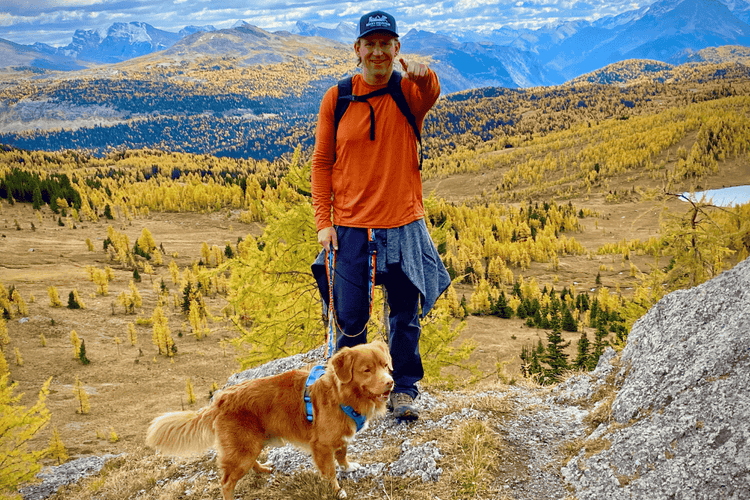Fall is one of the best times to hit the trails with your dog. Crisp air, colorful leaves, and fewer crowds make autumn hiking an absolute treat. But with cooler temperatures, shorter daylight hours, and slippery trails, preparation is key.
This guide covers everything you need to know about fall hiking with your dog, from gear and safety tips to hydration, nutrition, and post-hike care, so you can enjoy a safe and fun adventure together.
1. Choose dog-friendly trails for fall hiking
Not all trails are suitable for dogs (a travesty, we know), especially in the fall when conditions can change quickly. Before heading out, research your trail options and review local regulations, including leash requirements and seasonal restrictions.
Trails with steep inclines or thick leaf coverage can be slippery, so aim for moderate routes that reduce the risk of falls. Keep in mind that wildlife activity increases during fall, with elk rutting and bears foraging before hibernation, so leash your dog where needed and avoid high-risk areas. Planning ahead ensures a safer, more enjoyable experience for both you and your pup.
2. Pack the essentials for your dog

Before hitting the trail, it’s important to pack the right gear for your dog. Autumn hikes bring cooler temperatures, wet leaves, and shorter daylight, so having the essentials can make the difference between a comfortable, safe adventure and a stressful one. From hydration and safety gear to snacks and first aid, here’s what every dog should have on a fall hike:
Water Bowl & Fresh Water
Hydration is essential even in cool weather. A lightweight, collapsible bowl makes water breaks easy and clean. Bring enough water for the entire hike, dogs can dehydrate quickly, even in chilly temperatures.
Durable leash
all weather can be unpredictable, especially in the mountains, so it's essential to get one of the best dog leashes for hiking: durable, weather-resistant, and designed specifically for rugged outdoor use.
Trail Snacks & Energy Treats
Hiking burns calories quickly. Pack high-protein, bite-sized treats to maintain your dog’s energy and reward good behaviour along the way.
Dog First Aid Kit
Accidents can happen on any trail, from scrapes and cuts to minor paw injuries. Having a first aid kit on hand lets you quickly treat your dog and keep the adventure safe and stress-free.
Waste Bags
It's not glamorous, but even in the backcountry, it’s important to pick up after your dog. Bring more poop bags than you think you’ll need, and don't forget a hands-free way to carry them, like our waste bag holder.
LED Safety Collar
Shorter days make visibility crucial. An LED collar ensures your dog is easy to spot at dusk, in dense forest, or when off-leash in safe areas. Lightweight, rechargeable, and built for outdoor use, it’s a must-have for fall adventures.
3. Know when to leash and unleash Your Dog
Letting your dog off-leash is tempting, especially in the wide-open wilderness, but it’s important to assess the situation before. Aside from any leash regulations, consider your dog’s recall skills. Does he reliably come back when called, even when distracted? If not, keep him on the dog hiking leash.
Even for dogs with excellent recall, consider the environment. Are there other dogs, children, or wildlife nearby? Are you near a steep, exposed drop-off or fast-moving river? If the surroundings present any risk, keep your dog leashed...not only for their safety but others’, too.
4. Dress for the Weather

In the fall, one minute can be sunny, and the next, it’s chilly and raining. Make sure both you and your dog are prepared for whatever Mother Nature throws your way. For you, dress in layers and always pack a waterproof jacket in case of sudden showers. Later in the season, bringing a pair of microspikes is smart—especially if you’re hiking at higher elevations where frost or ice can make trails slippery.
For dogs, layering is just as important. A water-resistant or insulated jacket helps keep your pup warm and dry on ridges or during unpredictable weather. For more guidance on choosing the right gear, check out our articles on why your dog needs a rain jacket and how to keep your dog warm with winter coats.
Paw protection is also important—wet leaves, mud, and frost can be tough on sensitive pads. After the hike, dry your dog thoroughly to prevent chills. For added protection, consider dog goggles, which shield your pup’s eyes from harsh UV rays, wind, and debris on exposed trails. Visibility remains a priority: bright or reflective jackets combined with the LED collar ensure your dog can be seen at all times, reducing the risk of accidents in low light.
5. Hydration & Nutrition on Fall Hikes
Even in cooler weather, your dog needs frequent water and proper nutrition to maintain energy levels. Offer water every 20–30 minutes, and avoid letting your dog drink from streams or puddles, which may contain parasites. Bring high-protein, bite-sized treats for energy boosts along the way rather than feeding a single large meal. This helps keep your dog alert, active, and happy throughout the hike.
6. After the hike: Recovery and care

After a fun day on the trail, your dog still needs care to recover fully and avoid injuries or discomfort. Fall hikes can leave paws damp or scratched, and ticks or debris may cling to fur. Spending a few minutes on post-hike care ensures your pup stays healthy, happy, and ready for the next adventure:
- Check paws – Remove burrs, sticks, or debris, and inspect for cuts.
- Tick check – Fall is still tick season in many areas. Inspect ears, belly, and under collar.
- Dry your dog – Damp fur can chill your dog quickly. Towel off wet areas.
- Reward & rest – A cozy spot and fresh water help your dog recover.
7. Bonus: Common Fall Hiking Questions (FAQ)
Can dogs hike in cold fall weather?
Yes, most dogs can hike in cool fall temperatures, but their tolerance depends on size, breed, coat type, and age. Short-haired, small, or senior dogs are more sensitive to the cold and may need a jacket or vest to stay comfortable. Always monitor your dog for signs of shivering, slowed pace, or reluctance to continue, and adjust your hike accordingly.
When should my dog wear a jacket?
Dogs should wear a jacket in chilly, windy, or wet conditions—typically below 10°C (50°F), or if your dog has a thin coat or is elderly. Jackets protect against cold, rain, and wind, helping your dog maintain body heat and energy. Layering is optional for longer hikes or sudden weather changes.
Are ticks still a concern in fall?
Yes. Ticks can remain active until consistent freezing temperatures. Even on cooler days, check your dog’s ears, belly, paws, and under the collar after every hike. Using a tick preventive and keeping your dog on trails rather than in tall grass can also reduce risk.
How long can dogs hike?
Hike length depends on your dog’s fitness, breed, and experience. Start with shorter trails and gradually increase distance and difficulty. Pay attention to your dog’s energy levels, paw condition, and temperature tolerance, taking breaks as needed for water and snacks.
Explore safely with your pup
With the right preparation, fall hikes can be some of the most rewarding adventures you share with your dog. Remember to pack essentials like water, a durable leash, a cozy jacket, treats, and the LED collar to keep your pup safe and visible. Check paws, watch for ticks, and give plenty of rest and water after each hike. By taking these simple steps, every trail becomes a safe, fun, and memorable experience for both you and your furry companion.
Ready to hit the trails? Explore our Dog Hiking Gear Collection to find all the gear you need for fall adventures.

